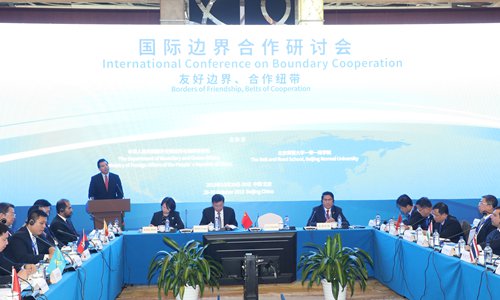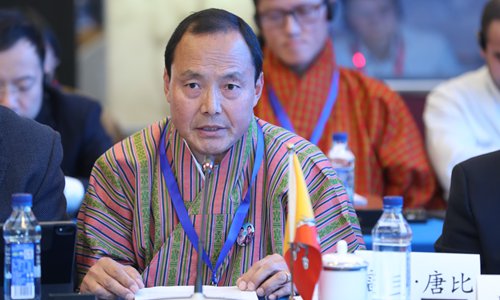HOME >> CHINA
Scholars, officials of China’s neighboring countries discuss boundary cooperation in Beijing
By Liu Xin and Fan Lingzhi Source:Global Times Published: 2019/11/3 16:38:39
Editor's Note:
A glimpse of the map of China shows the country's long boundary lines. As a country with one of the longest boundary lines and most neighboring countries in the world, China's demarcation work with other countries is complicated. Officials and scholars shared "stories behind the map" at an international conference on boundary cooperation, which was jointly held by the Department of Boundary and Ocean Affairs of China's foreign ministry and the Belt and Road School of Beijing Normal University on October 29 and 30.

Why are boundaries important?
Boundaries for some may just be a few lines on a map far away from their daily lives. When crossing a border there is no line between one country and another. The landscape might even be the same. Borders, however, have been seen as the "life line" for a country's sovereignty, territorial integrity, stability and prosperity.
Without a stable boundary line, there will always be potential for disputes, which affects the sovereignty and development of a country, Hong Liang, director general of the Department of Boundaries and Ocean Affairs, said during the conference.
China shares a land border with 14 countries - North Korea, Russia, Mongolia, Kazakhstan, Kyrgyzstan, Tajikistan, Afghanistan, Pakistan, Bhutan, Laos, Myanmar, Nepal, Vietnam and India.
The two-day conference held by China was the first of its kind, attracting officials and scholars from 14 countries, including 12 of China's neighboring countries and two other Asian countries.
During the conference, a guest interrupted another guest's speech because a map wrongly displayed a disputed area between two neighboring countries. This shows how serious representatives treat their sovereignty.
China has settled its boundary lines with 12 neighboring countries through peaceful negotiations since 1949, accomplishing the demarcation work of 90 percent of its borders.
Most of the disputes between China and its neighboring countries over boundaries are related to historical issues, said Zhang Qingmin, dean of the Department of Diplomacy with the School of International Studies at Peking University.
Zhang said that China and other Asian countries did not have the concept of sovereignty in the past. The West brought the concept to the region and Western colonists signed treaties with many Asian countries on border lines.
"Nowadays, we can finally settle the border disputes by ourselves and in our way," Zhang said.
Many guest speakers at the conference mentioned history. Mohd Hassan Faizee, director general of the security cooperation and border affairs directorate with the Ministry of Foreign Affairs of Afghanistan, said that Afghanistan determined most of its borders with neighboring countries at the end of the 18th century and the beginning of the 19th century. The border of Afghanistan and Iran was determined by British military officers and later determined by Turkish military officers.
Faizee mentioned that there are some issues left from the colonial era, including the Durand Line, which is at the root of the border dispute between the two countries.
The Durand Line was originally established in 1893 between Mortimer Durand, a British diplomat and civil servant of the British Raj, and Abdur Rahman Khan, the Afghan Emir, to fix the limit of their respective spheres of influence and improve diplomatic relations and trade.
An official from Cambodia talked about the negotiations on the border between Cambodia and Laos. He said that the two countries have settled 86 percent of it. To deal with the remaining problems, the leaders of the two countries sent a joint letter to France, hoping it could help find official records from the colonial era.

Friendship out of negotiations
"Boundary lines are not actual lines in reality - they are usually marked by some landmarks. After two countries set boundary marks and publish maps, boundary lines have a specific position and become the main basis for dealing with disputes in border areas," said Wang Xiaoding, a retired senior colonel from the Ministry of National Defense.
Scholars and officials at the conference said there would be some special arrangements in consideration of residents living in the border areas. For example, China and Nepal allow herdsmen living in the border areas to use areas across the border lines for pasture.
But negotiations on boundaries can easily go awry and can lead to international conflicts. "But China's negotiations with Russia, Kazakhstan, Kyrgyzstan and Tajikistan on boundaries did not go badly. We developed friendships and came out with a mechanism, which later became the Shanghai Cooperation Organization," said Xing Guangcheng, director of the Institute of Chinese Borderland Studies of the Chinese Academy of Social Sciences.
Xing noted the boundary talks between China and the Soviet Union were tough, and after 1991, China needed to solve the boundary talks with four parties.
"We all abandoned the Cold War mentality and solved our problems on the basis of the Five Principles of Peaceful Coexistence. This was a classic example that the international community could study," Xing said.
Wang Yanyong, director of the Boundary Affairs Office of Southwest China's Yunnan Province, also attended the cooperation conference. He told the Global Times that staff from China and neighboring countries have deepened mutual trust and friendship during joint patrols along the border.
During China's and Myanmar's joint patrols, Wang shared how both sides forged friendly relations. "We take them as neighbors and friends, caring about them in daily life. We also arrange entertainment activities. We had become good friends when it came to the end of the work. Many of our Myanmar counterparts shed tears when we said farewell," Wang said.

Prosperous border area
Settling boundary lines is never easy, but the work is important.
Malyshev Vladimir, a consultant with the Secretariat of the Collective Security Treaty of Russia, was involved with China-Russia border negotiations for many years.
He said that many methods and mechanisms created by China and Russia for boundary talks were very "effective and successful" and set examples for other countries.
China has done a lot of work on boundary negotiations with neighboring countries for the past 70 years. Among its 14 neighboring countries, only India and Bhutan have not finished the border negotiations with China.
Zhang Qingmin from Peking University told the Global Times that some Western politicians and Western countries pay a lot of attention to China's boundary issues, especially regarding the South China Sea. Most of the boundary talks have been completed.
Xing said that China has more successful experience with solving boundary problems peacefully than other countries. So the current discussions about the "China Threat" or hyping China's conflicts with neighboring countries are baseless.
India did not send representatives to attend the two-day conference. Zhang said that whether India attends the conference or not, it will not change the principles of equality and mutual benefit on which border issues should be solved.
"I expressed my opinions to the representatives from Bhutan, who totally agreed with me," Zhang said.
A clear and stable boundary leads to prosperity. Luo Zhaohui, deputy minister of foreign affairs, said at the conference that China is working to build a stable and prosperous boundary line and has signed agreements with 10 countries on boundary management.
China has signed protocols to open 106 ports. The country has established or plans to establish 17 national-level economic cooperation zones in border areas.
Cross-border cooperation helps to increase free trade and people-to-people exchanges as well as promoting regional development, scholars said.

Newspaper headline: Stories behind the map
A glimpse of the map of China shows the country's long boundary lines. As a country with one of the longest boundary lines and most neighboring countries in the world, China's demarcation work with other countries is complicated. Officials and scholars shared "stories behind the map" at an international conference on boundary cooperation, which was jointly held by the Department of Boundary and Ocean Affairs of China's foreign ministry and the Belt and Road School of Beijing Normal University on October 29 and 30.

Visitors and residents from China and Vietnam cross the two countries' border in Fangchenggang, South China's Guangxi Zhuang Autonomous Region on December 3, 2018. Photo:VCG
Why are boundaries important?
Boundaries for some may just be a few lines on a map far away from their daily lives. When crossing a border there is no line between one country and another. The landscape might even be the same. Borders, however, have been seen as the "life line" for a country's sovereignty, territorial integrity, stability and prosperity.
Without a stable boundary line, there will always be potential for disputes, which affects the sovereignty and development of a country, Hong Liang, director general of the Department of Boundaries and Ocean Affairs, said during the conference.
China shares a land border with 14 countries - North Korea, Russia, Mongolia, Kazakhstan, Kyrgyzstan, Tajikistan, Afghanistan, Pakistan, Bhutan, Laos, Myanmar, Nepal, Vietnam and India.
The two-day conference held by China was the first of its kind, attracting officials and scholars from 14 countries, including 12 of China's neighboring countries and two other Asian countries.
During the conference, a guest interrupted another guest's speech because a map wrongly displayed a disputed area between two neighboring countries. This shows how serious representatives treat their sovereignty.
China has settled its boundary lines with 12 neighboring countries through peaceful negotiations since 1949, accomplishing the demarcation work of 90 percent of its borders.
Most of the disputes between China and its neighboring countries over boundaries are related to historical issues, said Zhang Qingmin, dean of the Department of Diplomacy with the School of International Studies at Peking University.
Zhang said that China and other Asian countries did not have the concept of sovereignty in the past. The West brought the concept to the region and Western colonists signed treaties with many Asian countries on border lines.
"Nowadays, we can finally settle the border disputes by ourselves and in our way," Zhang said.
Many guest speakers at the conference mentioned history. Mohd Hassan Faizee, director general of the security cooperation and border affairs directorate with the Ministry of Foreign Affairs of Afghanistan, said that Afghanistan determined most of its borders with neighboring countries at the end of the 18th century and the beginning of the 19th century. The border of Afghanistan and Iran was determined by British military officers and later determined by Turkish military officers.
Faizee mentioned that there are some issues left from the colonial era, including the Durand Line, which is at the root of the border dispute between the two countries.
The Durand Line was originally established in 1893 between Mortimer Durand, a British diplomat and civil servant of the British Raj, and Abdur Rahman Khan, the Afghan Emir, to fix the limit of their respective spheres of influence and improve diplomatic relations and trade.
An official from Cambodia talked about the negotiations on the border between Cambodia and Laos. He said that the two countries have settled 86 percent of it. To deal with the remaining problems, the leaders of the two countries sent a joint letter to France, hoping it could help find official records from the colonial era.

Representatives from 14 countries in Asia attend a conference on boundary cooperation in Beijing on October 29 and 30. Photo: Liu Xin/GT
Friendship out of negotiations
"Boundary lines are not actual lines in reality - they are usually marked by some landmarks. After two countries set boundary marks and publish maps, boundary lines have a specific position and become the main basis for dealing with disputes in border areas," said Wang Xiaoding, a retired senior colonel from the Ministry of National Defense.
Scholars and officials at the conference said there would be some special arrangements in consideration of residents living in the border areas. For example, China and Nepal allow herdsmen living in the border areas to use areas across the border lines for pasture.
But negotiations on boundaries can easily go awry and can lead to international conflicts. "But China's negotiations with Russia, Kazakhstan, Kyrgyzstan and Tajikistan on boundaries did not go badly. We developed friendships and came out with a mechanism, which later became the Shanghai Cooperation Organization," said Xing Guangcheng, director of the Institute of Chinese Borderland Studies of the Chinese Academy of Social Sciences.
Xing noted the boundary talks between China and the Soviet Union were tough, and after 1991, China needed to solve the boundary talks with four parties.
"We all abandoned the Cold War mentality and solved our problems on the basis of the Five Principles of Peaceful Coexistence. This was a classic example that the international community could study," Xing said.
Wang Yanyong, director of the Boundary Affairs Office of Southwest China's Yunnan Province, also attended the cooperation conference. He told the Global Times that staff from China and neighboring countries have deepened mutual trust and friendship during joint patrols along the border.
During China's and Myanmar's joint patrols, Wang shared how both sides forged friendly relations. "We take them as neighbors and friends, caring about them in daily life. We also arrange entertainment activities. We had become good friends when it came to the end of the work. Many of our Myanmar counterparts shed tears when we said farewell," Wang said.

Letho Tobdhen Tangbi, representative from Bhutan, delivers a speech during the conference. Photo: Liu Xin/GT
Prosperous border area
Settling boundary lines is never easy, but the work is important.
Malyshev Vladimir, a consultant with the Secretariat of the Collective Security Treaty of Russia, was involved with China-Russia border negotiations for many years.
He said that many methods and mechanisms created by China and Russia for boundary talks were very "effective and successful" and set examples for other countries.
China has done a lot of work on boundary negotiations with neighboring countries for the past 70 years. Among its 14 neighboring countries, only India and Bhutan have not finished the border negotiations with China.
Zhang Qingmin from Peking University told the Global Times that some Western politicians and Western countries pay a lot of attention to China's boundary issues, especially regarding the South China Sea. Most of the boundary talks have been completed.
Xing said that China has more successful experience with solving boundary problems peacefully than other countries. So the current discussions about the "China Threat" or hyping China's conflicts with neighboring countries are baseless.
India did not send representatives to attend the two-day conference. Zhang said that whether India attends the conference or not, it will not change the principles of equality and mutual benefit on which border issues should be solved.
"I expressed my opinions to the representatives from Bhutan, who totally agreed with me," Zhang said.
A clear and stable boundary leads to prosperity. Luo Zhaohui, deputy minister of foreign affairs, said at the conference that China is working to build a stable and prosperous boundary line and has signed agreements with 10 countries on boundary management.
China has signed protocols to open 106 ports. The country has established or plans to establish 17 national-level economic cooperation zones in border areas.
Cross-border cooperation helps to increase free trade and people-to-people exchanges as well as promoting regional development, scholars said.

Newspaper headline: Stories behind the map
Posted in: IN-DEPTH